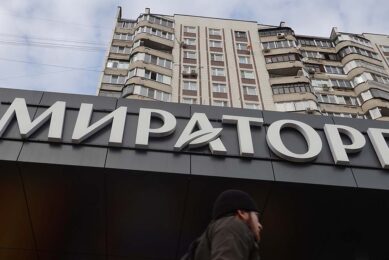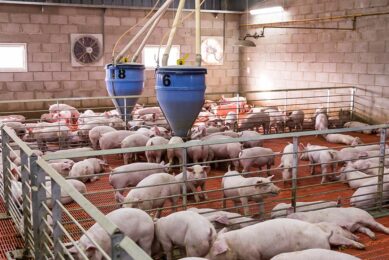Outlook 2010: Food for thought
The annual outlook by the British Pig Executive focused on green themes this year. How to be more sustainable in agriculture and in pig production?
By Stuart Lumb
©
The annual conference of the UK’s British Pork Executive (BPEX) and the English Beef and Lamb Executive (EBLEX) was held on 14 April in London. As always it attracted a high profile audience, with many attendees coming from the food retailing sector.
©
Mark Driscoll, head of One Planet Food Programme, WWF-UK spoke about the theme of ‘Why we need to address our production and consumption footprint’. He said that food eaten in the UK accounts for 18-20% of our carbon footprint, but when land use change is considered, this rises to 30%. He added that food production must double by 2050 as the world population is increasing, noting that diets are changing as well, with growing demand for milk and meat. In addition, he said biofuels currently are competing with animals for feed grains.
©
Driscoll went on addressing some problems: at the moment 40% of food is wasted; climate change is making fresh water scarce so water management must be improved; 1 billion people being obese whilst at the same time 1 billion are malnourished.
©
He said what is needed is a secure, sustainable food system with minimum environmental impact – low carbon, minimum water footprint, maintaining biodiversity both in the UK and overseas. The same amount of commodities must be produced more efficiently and with less impact, and consumer patterns must change.
©
Driscoll highlighted a recent WWF/ FCRN report which assessed the greenhouse gas emissions from the UK food system and the scope for reductions by 2050. “This report explored the scenarios for achieving a 70% cut in emissions from UK food consumption and is the first systematic attempt to account for consumption emissions including land-use change.”
©
He mentioned three potential reduction scenarios:1. De-carbonisation: Using more diesel fuel; also using electricity rather than gas to produce fertiliser.2. Emissions–led: Direct greenhouse gas emissions – reducing direct emissions to the atmosphere: Reducing waste and improving crop yields. 3. Consumption–led: Need to change consumption patterns plus more conservation by means of recyling thereby cutting waste.Driscoll said that if these initiatives are acted upon then a 70% reduction in food greenhouse gases by 2050 is achievable – ‘but it is clear that this cannot be done in the current policy context’. The final part of Driscoll’s paper honed in on how to reduce production greenhouse gas emissions. He said these emissions can be reduced by reducing food waste, plus using food waste and manure to generate biogas and electricity. Direct emissions (e.g. refrigerants) should be reduced. In terms of primary production, efforts should be accelerated to breed higher yielding crop varieties and more use should be made of lower quality feeds for livestock.
©
Pigs and environment
Anthony Kleanthous is the founder of Here Tomorrow, and is also senior policy advisor on sustainability at the UK branch of the World Wide Fund. His paper was entitled ‘Pigs and the Environment’. He reminded his audience of the fact that the standard of living is rising throughout the world. Zooming in on China, he said that its traditional meat is pork and consumption is expected to rise from 40 million tonnes in 2005 to nearly 70 million tonnes by 2030. Hence, extra land has to be found to grow feed, in particular maize and soybeans, to satisfy these swelling pig numbers. Increased production leads to increases in nitrates, phosphates and ammonia (eutrophication) which can all affect the environment, Kleanthous said.
©
He said water is a scarce resource – water in some aquifers, once extracted, will never be replaced. Also, intensive agriculture tends to increase run-off and transpiration, whereas extensive agriculture tends to maintain soil moisture and reduce erosion.
©
As far as greenhouse gases are concerned, he said the main sources of pork-related greenhouse gases are nitrous oxide (from fertiliser) and CO2emitted by the burning of fossil fuels used for transport, processing, retail operations and cooking.
©
Kleanthous added that greenhouse gases can be mitigated by using less soya in pig feed and this soya should be RTRS soya – sourced from the Round Table on Responsible Soya Association. Genomics can be used to breed more prolific sows producing offspring which grow faster and convert feed more efficiently. “In the UK, new anaerobic digesters will pay for themselves in five years,” commented Kleanthous. Furthermore, improved manure management and biogas production from anaerobic digestion help reduce greenhouse gases, he said. Waste should be reduced and, more controversially, consumers should eat less pork.
©
©
| Kleanthous: What can producers do? 1. Use renewable energy, produced by anaerobic digestion 2. Develop complete on-farm ecosystems 3. Practice mixed farming methods 4. Use sustainable feed (from waste, by-/ co-products, RSPO-certified sources etc.) 5. Reduce/ manage water (‘crops per drops’) 6. Eliminate artificial fertilisers and pestcides 7. Manage for high biodiversity 8. Eliminate waste 9. Lobby to make all of the above easy & profitable 10. Add value to meat products (organic/ freedom foods/ higher quality/ farmer information, etc.) © |
Source: Pig Progress magazine Volume 26. No. 5
Join 18,000+ subscribers
Subscribe to our newsletter to stay updated about all the need-to-know content in the pigsector, three times a week. Beheer
Beheer










 WP Admin
WP Admin  Bewerk bericht
Bewerk bericht